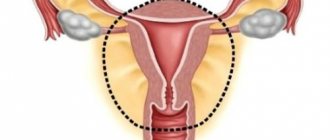One of the rather serious troubles during pregnancy is the appearance of symptoms of leakage of amniotic fluid in the second trimester. Such a condition can be extremely dangerous for the fetus, as it leads to major complications during gestation or already at the stage of labor. Amniotic fluid performs a lot of functions during pregnancy. Any changes in its composition or quantity pose a direct threat to the baby being born and the gestation as a whole.
There is no need to take risks by taking medications on your own.
What is leakage?
Amniotic fluid is essentially a biological fluid in which the fetus swims, like a fish in an aquarium.
Water is formed at the end of the second week from the moment of fertilization, and by the 14th week the amniotic sac is completely filled with fluid coming from the woman’s bloodstream.
The composition of amniotic fluid includes proteins, minerals, hormones, salts and carbohydrates. After 20 weeks, the baby’s urine is added to this rich composition.
The main tasks of the fluid:
- Maintaining a constant temperature around the fetus.
- Preventing injury to a child, for example, if the mother falls.
- Protecting the fetus from infection, as well as from pressure from the walls of the uterus.
In the vast majority of cases, spontaneous rupture of the membranes occurs during labor or before the onset of contractions. But sometimes, due to injury, infection or the threat of miscarriage, the walls of the amniotic sac lose their integrity and water leaks.
In obstetrics, a distinction is made between prenatal rupture of amniotic fluid and leakage:
- The process of discharge of water manifests itself in the form of a one-time outpouring of a copious amount of light, slightly cloudy liquid. In this case, cramping pain occurs, which indicates the onset of labor.
- Leakage of water , in contrast to overflow, is a pathological condition that requires immediate medical attention.
How often does it occur?
Unfortunately, not a single pregnant woman is immune from leakage of amniotic fluid.
Even in the United States, where the level of medicine is one of the highest in the world, every fifth case of death of a newborn child occurs due to premature rupture of the membranes.
If we talk about Russia, then, according to statistics, 10% of expectant mothers experience leakage. Diagnosing this alarming condition can be difficult due to the fact that in the early stages, women have a strong increase in vaginal secretion, and in the later stages, urinary incontinence often occurs.
About 1/5 of pregnant women at least once experienced symptoms that are characteristic of premature rupture of the membranes, but they carried their children to term normally.
Diagnosis becomes especially difficult when the bladder ruptures on the side or when a small crack appears. In such cases, there is no abundant outflow, and the water leaks literally one drop at a time. Meanwhile, such microtraumas are very dangerous and can become a gateway for the penetration of various bacteria and other pathogenic microbes that cause infection of the fetus.
In late pregnancy, this can lead to premature birth, and in the first and second trimesters - to miscarriage or fetal death.
Thus, the closer to the expected date of birth, the higher the chances of giving birth to a healthy baby.
Signs and symptoms
Depending on the stage of pregnancy, symptoms of amniotic fluid leakage may vary.
How to recognize this pathology?
How does it look and feel on underwear?
It looks like an ordinary wet stain without color or odor, which, when dried, leaves no traces. No pain.
Leakage of amniotic fluid can be very pronounced, in which case the water simply flows down the legs. If the walls of the amniotic sac are not severely injured, then the water drips a little at a time, leaving transparent stains on the linen.
In the second trimester
Normally, discharge in the second trimester is under the influence of estrogen, which thins it out. That is why, starting from the twelfth week of pregnancy, women observe watery spots on their underwear. They are odorless, can be transparent or whitish, and do not cause any discomfort, except for a feeling of wetness in the perineum.
This discharge is normal for the second trimester of pregnancy and does not require any specific measures, except for increased hygiene.
However, with close observation of the nature of the discharge and the general well-being of the pregnant woman, we can conclude that water is likely leaking:
- In contrast to mild urinary incontinence, the leaking amniotic fluid has a clear and watery structure and is odorless or accompanied by a sweetish aroma. Urine has a yellow color of varying intensity and has a strong smell.
- Vaginal discharge usually has a white, pinkish, yellowish tint, which is not typical for water.
- Leakage may worsen during any physical activity or with a sudden change in position.
- Over time, the symptoms become more pronounced, hyperthermia, nausea, vomiting and weakness appear.
A characteristic feature of leakage is the inability to control this process.
If urinary incontinence usually accompanies coughing or sneezing, then water leaks constantly, regardless of other physiological processes.
In the third trimester
By the beginning of the third trimester, the amount of amniotic fluid increases to meet the needs of the rapidly growing fetus. In later stages, damage to the walls of the amniotic sac increases the risk of premature birth.
In the third trimester, you need to pay attention to the following alarming symptoms:
- Significant increase in the volume of vaginal secretion.
- A continuously flowing stream of liquid discharge from the vagina (observed when the walls of the bladder are severely damaged).
- The abdomen visually becomes smaller, and oligohydramnios occurs.
- There is a wet spot on the sheet after sleep.
- When examining a woman by a gynecologist, a change in the condition of the uterine fundus is observed.
Determining leakage at home
It is important for every pregnant mother to know the main symptoms of amniotic fluid leakage.
How to reliably determine the leakage of amniotic fluid for a pregnant woman at home: In case of premature rupture of amniotic fluid, at least 400 ml of fluid is released. Water trickles down your legs, and it’s impossible not to notice it.
But if there is a high tear or a small crack, in this situation it is more difficult for a pregnant woman to find out about the integrity of the membrane.
In the absence of precious time and the opportunity to purchase a test to determine water leakage, at home, you can perform the following measures: A woman needs to completely empty her bladder, even if there is no urge to urinate, then perform a thorough toilet of the external genitalia and wipe the perineal area dry with a towel.
Lay on the bed, preferably, a white cotton sheet or a piece of cloth or a diaper. Lie down on a clean sheet, and after 10-20 minutes, look for wet spots on the dry fabric. If spots are present, the possibility of leakage of amniotic fluid cannot be ruled out.
But what if it’s not amniotic fluid, but say, heavy vaginal discharge? In such situations, the expectant mother needs to be able to distinguish amniotic fluid from vaginal discharge or urine.
The waters normally have a transparent color and consistency resembles ordinary water. Sometimes the water may have a greenish or brown tint - this indicates a serious pathology and requires immediate hospitalization.
Urine has a slightly yellowish color and a specific smell. As for the discharge, this depends on its nature, but it is thicker in consistency; in most women it is whitish in color and mucous.
Causes
There are many factors that cause premature rupture of intrauterine waters.
The most common cause of this phenomenon is urogenital infections.
They can have an extremely negative impact on the condition of the fetus and the female body.
In addition, leakage of amniotic fluid may be due to the following factors:
- inflammation in the cervix, vagina and amniotic sac;
- isthmic-cervical insufficiency;
- hormonal imbalances;
- polyhydramnios or oligohydramnios;
- injuries caused by falls or other abdominal injuries;
- excessive physical activity.
Can a pessary cause this?
The pessary has been used in obstetrics relatively recently, but has already proven itself as a means of helping with the threat of miscarriage arising from early dilatation of the cervix.
After the pessary is installed, the woman needs to pay special attention to the nature of the vaginal discharge. If their volume, color or smell has changed dramatically, you should consult a doctor as soon as possible to eliminate the possibility of leakage of amniotic fluid.
The body perceives the pessary as something foreign and may respond to it with an increase in vaginal discharge; this is a variant of the norm. However, if the discharge becomes thin and abundant, it is better to play it safe and do a test.
Preventive measures
To prevent amniotic leakage at 15-35 weeks, you need to show awareness in advance. Before conception, all infections and inflammations must be eliminated. Take a preventive course against exacerbation of chronic ailments.
During gestation, increased physical activity, traumatic injuries, and unhealthy addictions such as smoking are prohibited. If suspicious symptoms are detected, be sure to consult with the obstetrician-gynecologist monitoring this pregnancy.
Why is it dangerous?
The consequences of leakage of amniotic fluid may vary depending on the stage of pregnancy:
- In the first trimester, this most often leads to miscarriage or fetal death. Even if this does not happen, doctors strongly recommend artificial termination of pregnancy, since dehydration of the amniotic sac is likely to cause gross malformations of the child.
- In the second trimester, leakage of water is also considered the beginning of a miscarriage. The greatest danger is posed by intrauterine infection of the fetus, as well as infectious complications in the expectant mother. If timely measures are not taken, the inflammatory process affects the fetus and the woman within a day and a half. There are no exceptions to this rule.
- In the later stages, leakage of water can cause bleeding due to placental abruption or rapid labor.
You might be interested to know
Find out how twins are created.
Read this article about the movements of twins during pregnancy.
What consequences await a pregnant woman if water leakage is suspected?
The most insidious complication is intrauterine infection of the unborn baby.
The formation of infectious and inflammatory complications in the mother herself (inflammation of the layers of the uterus, inflammation of the membranes of the fetus). The effusion provokes the appearance of premature birth, or weakness of labor
Placental abruption As labor progresses, a premature baby develops distress syndrome (the baby’s lungs cannot independently participate in the act of breathing, due to their unpreparedness, they stick together and further independent gas exchange is impossible).
How it happens and what it looks like
Water may leak in different ways depending on the degree of rupture of the membranes. If most of the water flows out, then this will not go unnoticed by the woman.
Warm, cloudy liquid may flow down your legs, and your stomach will visually become smaller. If the damage to the amniotic sac is minor, then water may leak little by little, so the expectant mother may not immediately pay attention to it.
Women usually notice wet spots on their underwear or panty liners. They have neither color nor smell.
From my experience I will say that it is impossible not to notice the outpouring of water. For me this was accompanied by a slight pop inside my stomach, and my underwear instantly became wet. And immediately after the effusion, I felt better - the pressure in the uterus significantly decreased. And this happened in the upper fetus at 33 weeks of pregnancy.
How to determine leakage of amniotic fluid?
How to understand that amniotic fluid is leaking?
If a woman notices that during pregnancy the discharge has become more abundant and thin, she should immediately contact a gynecologist.
However, even an experienced doctor is not always able to see that damage to the amniotic sac has occurred. In this case, laboratory tests will provide invaluable assistance. Diagnostics is carried out as soon as possible.
Medical examination and smear
First of all, the doctor conducts a medical examination to visually assess the condition of the woman and the fetus. The gynecologist can also take a smear from the posterior vaginal vault.
The collected material is applied to a glass slide and stained with special reagents, after which it is examined under a microscope. During the study, it is possible to detect rejected cells from the child’s urinary and genital organs, as well as his skin.
This indicates damage to the walls of the amniotic sac.
How is it determined in the maternity hospital?
In the maternity hospital, a special test for leakage is increasingly used, and they also take a smear, which was discussed just above.
Test at home
Women can independently determine whether amniotic fluid is leaking using various tests.
Amnishur
The Amnishur test gives the most accurate result (99%) in 10-15 minutes. Taking it is as easy as taking a pregnancy test.
The reagent contains highly sensitive antibodies. They help to independently determine even the smallest amount of a special substance - placental alpha microglobulin-1 (hereinafter referred to as PAMG-1) in the secretions after rupture of the walls of the fetal bladder.
This protein is found in large quantities in the amniotic fluid and should not normally be found in the vagina.
Using the amniotic fluid detection test is very simple:
- It is necessary to take a sterile tampon, which is included in the kit, and insert it into the vagina, but not deeper than 7 cm, and leave the tampon inside for a minute, then immerse the polyester part of the tampon in a test tube with a pre-prepared solution, rotating the tampon for 1 minutes.
- Next, the swab is removed from the test tube, and the test strip is immersed in it.
- If the flow of amniotic fluid is abundant, the test will respond within a few seconds. If the leakage is minimal, you will have to wait up to five minutes.
- If the amniotic sac is damaged, two lines will be visible on the test.
In the video you will find detailed instructions on how to use the test:
During my pregnancy, there were similar tests on sale, but without a jar of liquid. When I had intense discharge from the pessary, the test practically did not change color. And when the water broke, it instantly turned purple.
The test I used looked like this:
Frau test pad
This test is also, with a high degree of reliability, capable of distinguishing placental fluid from vaginal secretions and urine.
It is presented in the form of a gasket with a test strip containing a polymer that changes its color from yellow to green-blue when interacting with a liquid with a high pH value.
Gaskets for detecting leakage of amniotic fluid are very convenient to use.
They are attached to underwear in the same way as a regular pad. Should be worn for 12 hours. A special insert reacts to the pH value of vaginal discharge.
If this indicator tends towards an alkaline pH, then the liner changes color.
This test eliminates false results due to contact with urine.
For instructions for use, watch the video:
Dry diaper method
It is necessary to place a clean white diaper folded in several layers between your legs. After a few hours, you should see what the wet spot looks like: if it has clear contours and is small in size, then it is most likely discharge. And if the spot spreads across the diaper, without any special boundaries, it is amniotic fluid.
Probability of error
The accuracy of pharmacy tests is very high and reaches 99%. A false result may be caused by improper use of the test or failure to follow the instructions supplied with the test. The dry diaper method is very subjective and ambiguous, its reliability is low.
Is it visible on ultrasound?
Using ultrasound, you can only determine indirect signs of amniotic fluid leakage, for example, a lag in the amount of amniotic fluid for a certain stage of pregnancy.
The study is not very informative, since it may indicate more than just leakage.
How to distinguish between discharge and thrush?
Amniotic fluid differs from vaginal discharge in consistency (the water is more liquid), color (the water is transparent, and the discharge has a white, yellowish, pinkish tint).
If the discharge is abundant, then leakage of amniotic fluid is very likely. How to determine this exactly? Of course, with the help of a test or by consulting a doctor.
How to distinguish from urinary incontinence?
Urine has a yellow tint and a pungent odor, and amniotic fluid is odorless or has a sweetish aroma and is almost colorless.
Does your stomach hurt?
With minor leakage, the stomach practically does not hurt. Painful sensations can occur when there is very little amniotic water left in the fetal bladder.
In my case there was no pain.
Is it possible to have no contractions?
Normally, amniotic fluid is released during contractions and marks the beginning of labor. If leakage occurs before the expected date of birth, the woman needs to take a test and, if a positive result is obtained, consult a doctor as soon as possible.
I didn’t have contractions, nor did I have them for two days after my discharge.
Sticky or not?
Amniotic fluid is not sticky; its consistency resembles ordinary warm water, sometimes slightly cloudy.
Can it happen with twins?
Premature leakage of amniotic fluid is possible both when carrying one child and during multiple pregnancies. Due to the heavy load on the amniotic sac, the risk of damage to its walls also increases, so leakage of amniotic fluid is more common in twins.
My water broke on my upper fetus. And for two days he was without water, and for the next day he was with water.
The value of amniotic fluid
Amniotic fluid is just water in which the baby floats, as most patients believe, which is not entirely true. 98% of amniotic water is indeed just that, however, it is still not just water. It contains a variety of microelements that supply the fetus with everything it needs. It looks like a pale yellowish transparent liquid substance that surrounds the fetal tissues and provides them with additional nutrition. In addition, amniotic fluid helps the baby develop skeletal and muscle structures.
Amniotic fluid in pregnant women is located in the bladder around the fetus and has two membranes - chorionic and amniotic. They hold the baby in a bladder filled with amniotic fluid. The filling of this sac begins after fertilization, a few days later. Throughout gestation, the baby will gradually excrete urine into the water, from about 10 weeks, when his renal system gradually begins to function.
Additional factors
Amniotic fluid performs a lot of functions; it fills the bladder, providing a favorable environment for fetal development. The fetus moves calmly, and when it collides with the uterine walls, the water softens the blow, neutralizing the unpleasant sensations. In addition, the functions of amniotic fluid include:
- Isolation of the baby from infectious processes and pathogens;
- Protecting the umbilical cord;
- Protective functions from external mechanical influence;
- Prevention of bleeding during gestation and delivery;
- Facilitation of childbirth;
- Help in the full formation of the fetal vascular system;
- Full physical development of the baby, since the fluid protects against the fusion of various fetal parts of the body;
- Thermoregulatory tasks;
- Maintaining material exchange processes;
- Fetal protection at the immune level.
During gestation, the water is periodically renewed, but no changes occur in the chemical composition. The approximate volume of amniotic fluid before delivery is about one and a half liters. Towards the end of the gestational period, in the third trimester of pregnancy, the vesical walls begin to rupture and fluid leaks out. But sometimes partial leakage is detected much earlier, which is dangerous for the fetal and maternal body.
What to do if the result is positive
If the amniotic fluid test result is positive, you must immediately consult a doctor who will conduct additional diagnostics and take all measures aimed at maintaining the pregnancy.
Is it possible and how to stop it?
The process of leakage of amniotic fluid cannot be stopped. You can only prolong the gestation of the child to the maximum possible period.
How long can they leak?
From several days to several months. It all depends on the woman’s body and the doctor’s tactics for managing pregnancy.
Can it stop on its own?
In no case should you expect the leakage of amniotic fluid to stop on its own. If the walls of the amniotic sac are damaged, the child and mother will become infected very quickly, and this, in turn, can lead to irreparable consequences.
Are the waters replenished?
Normally, the water is renewed every three hours, but if it leaks, this process cannot provide the child with all the necessary substances.
Is it possible to save a child?
The answer to this question depends on the stage of pregnancy. In the third trimester, the chance of giving birth to a healthy baby if amniotic fluid leaks is high. If leakage occurs in the early stages, doctors insist on terminating the pregnancy.
As I wrote, my child was without water for two days. The doctor told me that with leakage it is possible to prolong pregnancy even for a whole month! (it all depends on the specific situation - term, condition of the mother and child, etc.).
The danger of premature release of water
Premature leakage of fluid from the fetal bladder carries a number of dangers for both the pregnant woman and the baby.
For woman
When the surface of the fetal bladder is damaged, its contents become unsterile, so there is a high risk of infection entering both the baby and the uterus.
Infection of the uterus usually leads to the death of the child and provokes the development of severe septic complications in the mother.
Did you know?
The uterus is a unique human organ that is capable of increasing in volume approximately 500 times during pregnancy and then returning to its original state.
Thus, the weight of a woman’s uterus in normal condition is approximately 40-60 g, the volume of its cavity is 5-6 cubic meters. cm, and by the end of pregnancy - 1-1.2 kg and 500 cubic meters. see accordingly .
For the fetus
If the leakage began before the 20th week, then additional tests will be required in order to decide whether it makes sense to prolong. Most likely, the cause of the complication was infection, and this is fraught with the development of a number of pathologies.
Often children in such cases are born blind, deaf, or suffer from severe respiratory failure or cerebral palsy. Therefore, doctors often decide to terminate the pregnancy. Rupture of the bladder at 25-27 weeks usually occurs due to the development of a urogenital infection.
A consultation of doctors must determine the possible risks for the child and decide whether to continue the pregnancy or terminate it. The risk of developing a disability in a baby is quite high.
At a period of 38-40 weeks, a slight rupture of the bladder and leakage of liquid from it does not pose such a strong threat to the baby as in previous periods. Typically, doctors currently resort to wait-and-see tactics.
Important!
The longer the period of amniotic fluid leakage lasts, the more serious complications may arise for the child and mother
.
Treatment
Treatment depends on the stage of pregnancy. After 35 weeks of gestation, the baby is ready for birth, so if amniotic fluid leaks, doctors perform the birth.
Are antibiotics needed?
For periods up to 22 weeks, antibiotics are prescribed to prevent infection. Next, the doctor assesses the amount of water loss.
In the third trimester, antibiotics are also prescribed in combination with tocolytic therapy and treatment with glucocorticosteroids.
I was given an antibiotic injection twice, but it still led to the development of pneumonia after birth in a child who was without water.
Is bed rest required?
Bed rest is required.
Prevention
In order to prevent leakage of amniotic fluid as much as possible, doctors advise:
- Eliminate possible foci of infection (pyelonephritis, diseases of the genitourinary system, dental diseases, etc.).
- Cure isthmic-cervical insufficiency in a timely manner.
- Use conservation therapy to eliminate the risk of miscarriage.
You might be interested to know
How does hCG increase during twins? A detailed description is in our article.
When does toxicosis begin during twin pregnancy? Find out here.
Do they give maternity capital for twins? Read here.
Diagnostics
Leakage of amniotic fluid can be determined at home. There are special tests for this that can be purchased at any pharmacy.
There are two types of tests:
- test strip.
- test pad.
Their mechanism of action is the same - determining changes in the environment (Ph) in the vagina. When amniotic fluid gets on the test (on a certain area), it turns green-blue. More detailed details are described in the attached instructions.
These tests do not provide a 100% guarantee, since the presence of an infectious process in the vagina can also lead to a change in Ph.
Important!
Remember that even if you suspect leakage of amniotic fluid, you must immediately inform your obstetrician-gynecologist, as this carries some risks.
Diagnostics on an outpatient basis
The doctor determines water leakage using a special smear. When amniotic fluid enters the vagina, a certain protein is found in it, which is found only in amniotic fluid.
Nuances
Is it dangerous during full-term pregnancy?
During a full-term pregnancy, the danger is minimal. The baby is already ready for birth, so doctors take a wait-and-see approach and, if necessary, begin delivery.
How not to miss it?
In order not to miss the leakage of amniotic fluid, it is necessary to carefully monitor the nature and volume of vaginal discharge. If you suspect damage to the amniotic sac, you need to do a test.
Is there a normal frequency of leakage?
How often and for what period can amniotic fluid leak? Normally, this does not happen at all until the last days of pregnancy.
Does it happen after the plug comes out or before?
Normally, the outpouring of water during contractions occurs after the plug comes out.
In my case, the plug came off two days after my water broke.
Normal amount of amniotic fluid
The level of amniotic fluid throughout pregnancy is determined using ultrasound and can be as follows:
- 12th week of pregnancy: 60 ml;
- 16th week of pregnancy: 175 ml;
- Weeks 34-38 of pregnancy: 400-1200 ml.
Towards the end of pregnancy, the amount of amniotic fluid should decrease in preparation for childbirth. Normally, the amniotic sac ruptures during the first stage of labor. At this time, the remaining fluid begins to flow out through the cervix and vagina.











